Vesper XB-8000 test, much more than a Class B AIS transponder
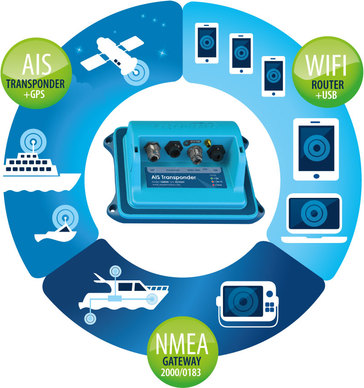 I’ve had a Vesper XB-8000 installed in the lab for the last month, and I’m confident that it will do well in a long test on board Gizmo beginning in May. I will miss some features of the Vesper Vision I tested last season, but having the blue box installed behind the scenes will help me test the glass bridge concept (one MFD brand, many screens), and at $799 I think the XB-8000 is a multifunction value that could work on a wide variety of vessels. The recent testing also revealed some new features that apply to both the XB and the Vision as Vesper continues to expand on the concepts expressed in the 3-in-1 diagram above…
I’ve had a Vesper XB-8000 installed in the lab for the last month, and I’m confident that it will do well in a long test on board Gizmo beginning in May. I will miss some features of the Vesper Vision I tested last season, but having the blue box installed behind the scenes will help me test the glass bridge concept (one MFD brand, many screens), and at $799 I think the XB-8000 is a multifunction value that could work on a wide variety of vessels. The recent testing also revealed some new features that apply to both the XB and the Vision as Vesper continues to expand on the concepts expressed in the 3-in-1 diagram above…
Let’s start with a look at XB-8000 results. The SEAiq app above is running on an iPad that’s connected by WiFi to the XB and it’s showing the same GPS and AIS data I saw coming from the Vision last summer. That’s quite useful in itself, but note the addition of depth and wind. The XB-8000 (or the Vision) can now serve as a NMEA 2000 gateway, translating data on my network into a form that can travel over WiFi and that many apps can understand. Only major N2K message types (PGNs) are supported — wind, depth, speed, heading, log and temperature so far — but the XB (and Vision) have other data gateway and multiplexer features.
Above is a screen from the much revamped Vesper PC (and Mac) Configuration and Status Utility software that owners can download here. Many of the settings aren’t available for any other transponder I’m aware of. For instance, checking those NMEA 0183 boxes above means that I could be sending the translated 2000 wind, depth, etc. data to an older MFD that didn’t have an N2K port or to a charting program running on the same PC that’s connected to the XB-8000 by USB cable (or via WiFi, as seen in the screen below).
Vesper has also significantly improved its NMEA 2000 GPS output. It’s always been confusing that while Class B AIS transponders are required to have good GPS receivers built in, their NMEA 0183 or 2000 GPS output is often unusable by other devices. This is true because many MFDs and chart plotters won’t recognize GPS as valid unless they see some or all of the secondary GPS data messages like “satellites in view,” but the standard NMEA 0183 AIS connection — though called “high speed” at 38,400 baud — barely has enough bandwidth to carry all the AIS target info for a busy area.
While charting apps and PC programs are often more liberal about GPS validity, it’s always seemed possible that a transponder with a much wider bandwidth N2K connection could provide enough GPS data to be the primary or backup GPS source for the fussier plotters on a network. As far as I know, though, Vesper is the first to do it, as partially illustrated above, and I saw it work pretty well in the lab.
The Raymarine a77 and e127 (that I’ve been testing LightHouse II on) as well as the Simrad NSS8 MFD and RS35 VHF radio all see the XB-8000 as a valid source of NMEA 2000 GPS (and of course all the MFDs also displayed the AIS target data it’s outputting). The Ray and Simrad GPS diagnostic screens above suggest how thorough the XB’s GPS output is (and I assume Vision output is the same). While many GPS receivers offer extra high update rates and/or GLONASS support these days, an AIS transponder that also serves as a GPS has extra value for many boats.
(Surprisingly, though, neither the Garmin 8212 or 741sx displays installed in the lab see the XB-8000 at all, not even on their N2K device lists, but I know for sure that Vesper and Garmin are working together to figure this out. The screen above may also reveal a possibly related Vesper GPS date translation glitch that just caught my eye yesterday, but it’s conceivable that both issues are somehow related to my particular test set up. I will definitely update both situations as they unfold in the comments section below. {Update: the date glitch had already been discovered and fixed, which I would have known if I’d registered the XB; see comments below})
Vesper’s utility software gives the XB-8000 the same flexible WiFi management that I experienced with the Vision. It’s not just easy to change its access point name (SSID), password, IP address, etc., but it’s also easy to have it join an existing onboard WiFi network (even with a preferable static IP address). The result on a boat like Gizmo is that tablets and phones can use XB data, while also being online and having app access to other onboard devices like a Fusion 700 stereo system.
I only tested WiFi client mode briefly in the lab (because my home WiFi signal is so weak there), but I did confirm that I could even use it to run AISdispatcher and thus send the XB target data to MarineTraffic (recent Panbo discussion here). I continue to lobby Vesper to build AISdispatcher-type functionality right into the XB and Vision, which would mean that a boat could serve as volunteer station while only running the transponder and perhaps a high power WiFi system like the Rogue Wave or NautiCloud. Please speak up if you, too, would value that extra feature.
Vesper’s own iPad and iPhone app WatchMate can’t do all the deep configuration that the PC and Mac software can, but it, too, has been improved. For instance, that informative AIS Plotter screen above is new. But what you can’t see on the screen is how all those target vessel names (and underlying detail) filled in the moment the app was opened. Vesper calls this feature “Instant Target Acquisition” and both the XB-8000 and Vision can only deliver it to the app, but remember, static target data like vessel names even when powered down. Usually, it takes a while for any AIS app or display to collect all the available static target data because it’s only broadcast every six minutes.
Vesper tells me that Instant Target Acquisition from the XB or Vision is available to any developer who’d like to work with them, and they try to maintain a list of apps that already work with Vesper WiFi output. They’ve also launched a partnership with an ambitious new iOS app called NavPlay.
In my preliminary testing, NavPlay is still a work in progress, and I also tend to agree with Francis Fustier’s pricing concerns. But it does have some lovely design features — you can draw a route with your fingertip — and I’m sure we’ll see it not only mature, but add new data integration features as Vesper adds them. In the meantime, I’ll close with a Coastal Explorer 2011 screen that nicely illustrates the power and value that the XB-8000 offers right now. CE is running on a PC that’s only connected to the lab’s NMEA 2000 network via XB WiFi, but look how many data sensors it sees.



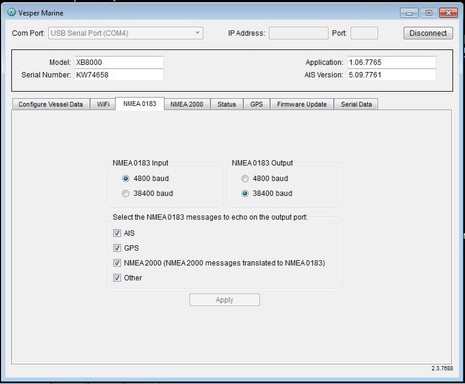
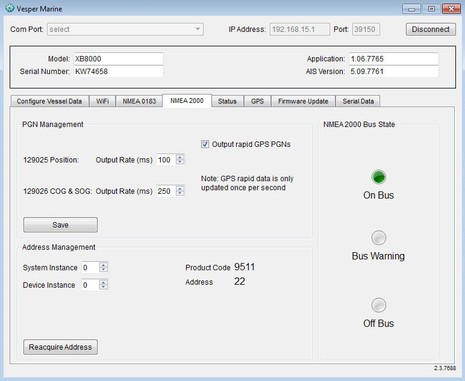


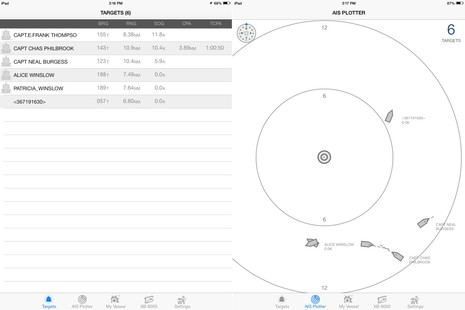
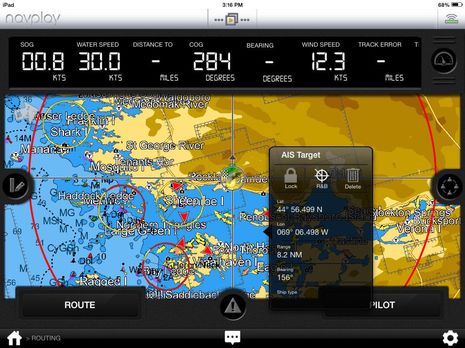


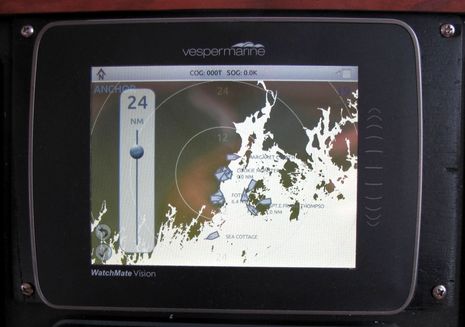
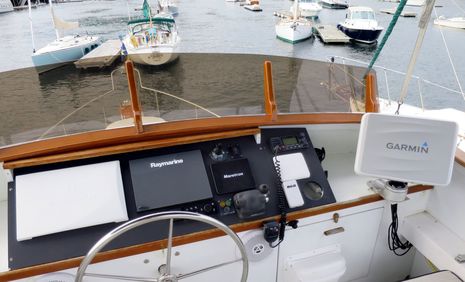









So it’s Monday in New Zealand and I learned that Vesper realized that the XB-8000 has an N2K GPS Date translation problem two weeks ago and has already created a fix. I think I’ll receive the software update in a day or two (not sure why they don’t post them for download).
It’s doubtful that fixing the GPS date problem will do anything for the Garmin 8xxx/7×1 incompatibility but weirder things have happened. After all, the Raymarine and Simrad MFDs have been showing XB-8000 GPS and AIS data just fine even though they think it’s all happening more than a year ago. So it wasn’t an obvious problem.
In fact I didn’t notice the date problme until I took GPS diagnostic screen shots, though now I can see that those screen shots are misdated and I’ll bet that long route ETA’s and track records are also dated oddly. So it’s non-obvious glitch with strange side effects.
Let me add that this is the first time I’ve encountered Vesper bugs, and I know they’re work hard to eliminate them.
Can the XB filter targets like the Vision does?
Ben,
The Vesper WatchMate App has a firmware update tool – is this the way Vesper wants us to download the fix for the date translation issue? I only have my XB-8000 installed a few weeks and have not used it underway, (still dodging snow in Maryland). I completely understand software glitches and appreciate the fix, but Vesper has to make getting updates as easy as Garmin does. It would be really nice to get an email notice of a new update from them as well.
Thanks, Russ. I definitely meant to cover that, though I’m afraid the answer is no, the WatchMate app does not do Vesper target filtering and alarming with the XB-8000. That may change but Vesper is vague about how much and also says that the app will always be able to do more with the Vision.
However, I think the genius of Vesper collision avoidance is all software. Many MFDs and apps have already improved their AIS filtering and alarming and I don’t know any reason they can’t get as good at as Vesper.
Richard, I’m told that the latest XB-8000 update hasn’t been “formally released” yet as they’re still field testing. I also learned that Vesper emails registered users about software updates and does post them online for download, though that’s not obvious on the main update page:
http://www.vespermarine.com/firmware-upgrades/
Cool! The test XB-8000 is now updated to app version 2.00.8056 and AIS Version 5.09.8055…and the GPS date is correct. When I registered the XB online I immediately got back an email with a link to the firmware download site and found an update dated March 14. (Apparently Vesper misinformed me about the release because the main guy handling updates wasn’t in today. And had I registered earlier I think I would have been notified.)
The preferred way to do the update is over WiFi using the VMais config program. That worked fine and is particularly nice for installers as they don’t have to even find the blue box and run a USB cable.
However, the update did not fix the Garmin 8212 and 741sx problem, which may be more to do with Garmin than Vesper.
WiFi is great value-added feature, but I’d like to request that Vesper and other AIS manufacturers incorporate a VHF antenna multiplexer in these units as standard. So far, only Garmin seems to recognize that eliminating the need for a second antenna is a hugely attractive feature. I suspect that having to spend an extra $200 for a MUX or the equivalent amount in money or hassle for a second antenna is delaying the uptake of AIS technology.
Saffy, there are lots of AIS/VHF antenna splitters specifically designed so that you can use the same antenna for both a transponder and a regular fixed marine radio. Check the selection at Defender:
http://www.defender.com/category.jsp?path=-1%7C135%7C2028691&id=2225655
Building the splitter and transponder into one box does eliminate a power feed and coax patch cable but the cost and results are pretty much the same, I think.
I get e-mails from Vesper when firmware updates are available with a link in the e-mail to download the update package. I’ve done 2 updates this way. Maybe because I registered the unit? Very easy.
Ben,
You made my point. There wouldn’t be so many splitters out there if there wasn’t demand for them. I’m guessing that if you integrated the MUX circuitry in the AIS unit and got rid of the second case, connectors, board, etc, you’d add maybe $20 to the COGS of the AIS unit while greatly simplifying installation and improving reliability compared to separates.
I’d like to see Vesper do this because they make good stuff and don’t just repackage SRT’s OEM guts they way most of their competitors do. If they were to integrate it, they’d jump out ahead until SRT developed it for their competitors, which could take a while. On the other hand, if SRT does it first, most of Vesper’s competitors will be able to jump ahead of them more or less simultaneously and that’ll put Vesper behind the 8 ball.
Saffy, that makes a lot of sense, however I would take it one step further.
It would be better if there was no substantial length of coax cable. It would be better if the transceiver was mounted outside with the antenna connected directly or with a short length of cable, and much like a modern radar, a cable with data and power ran from their down to a display in our cabin (or) we only had two or three remotes in our boat instead of a fixed mount display.
Dan, I’d take that in a heartbeat. I’ve got a power-over-ethernet Ubiquiti Bullet WiFi on my boat that also fits the pattern of putting the transceiver outside at the antenna. That said, as long as most of the boating world is using fixed-mount VHF heads with a remote antenna (including me) I think antenna sharing between the VHF and the AIS gets you 80% of the way to nirvana with 20% of the effort.
I’m still not getting it, Saffy. The Garmin AIS 600 retails at $999 while (SRT made) Emtrak transponder and splitter total $810 at West Marine: http://goo.gl/YAxvbn
I’ve used all that gear on Gizmo and I think the feature sets and performance are similar. Meanwhile, the Vesper XB-8000 and Splitter total $1,048 with quite a few extra features. Where’s the cost savings?
Meanwhile, a boater who wants to go all Garmin equipment but have a separate AIS antenna — preferable if you a spot for it, I think — is out of luck because Garmin doesn’t offer a plain Class B transponder. I don’t think any of the major manufacturers offer both types of transponders, but I believe that True Heading, Comar, and Digital Antenna all do. So it’s not like it’s hard to find a transponder with a built in splitter if it’s a big deal to you.
Dan, I’ve installed some transponders on my fly bridge close to the antenna mast and some down below, and doubt it made much difference. I’ve heard that DSC signals have better range than analog VHF and I think even 2 watt Class B AIS signals are pretty hardy.
Ben, I’m not saying that it’s impossible to get AIS transceivers with integrated splitters, just that there’s a big price premium to go from receive-only AIS to transceive AIS and it’s hindering expansion of the market to the point that it represents an existential risk to Vesper and others.
Here’s my situation, from which I’m extrapolating (possibly incorrectly, of course!) I’ve got an older VHF and want to add some AIS functionality. Right now, I can buy a Standard Horizon GX2200 with integrated GPS and AIS receiver for $400. All-in-one, no extra antennas, no extra boxes, big bang for the buck, and I even get a new VHF radio as part of the deal.
Now, let’s say I lust after an AIS transceiver rather than just receive functionality. Assuming my VHF is reasonably modern so I stick with it, I’m still looking at $800 minimum (an extra $400 or 2X the scenario above) to add a transceiver and splitter. Nevermind that if my VHF is old enough (e.g. no DSC), I have to add at least another $200 for a VHF upgrade. That’s a $600 delta (2.5X) versus the GX2200 receive-only solution.
Now let’s say the splitter in integrated into the AIS transceiver at a price of $550-$600 (not Garmin’s premium pricing model). Now the gap between the GX2200 receive-only solution and the transceiver add-on to the existing VHF is $150-$200. That’s “what the hell” territory for a lot of folks and it represents a lot of incremental business for Vesper and others who get there first.
Now let’s go down the road a couple years when Standard Horizon introduces their GX1000000 with integrated AIS transceiver, GPS, and trans-warp drive for $600. How’s Vesper and anyone else gonna compete at all in the new boat market, folks replacing pre-DSC VHFs, and anyone with $200 extra disposable income who’s looking at getting AIS transceive? The answer is that there’s going to be a bloodletting.
In the end, my point is that the AIS manufacturers risk getting their collective asses handed to them by Standard, Icom, and anyone else who comes out with an integrated AIS Transceiver/GPS/VHF. However, they can forestall that outcome if they can drive adoption of their products and lock the VHF companies out for another 5 year customer upgrade cycle. That incremental business can easily represent the difference between life and death for some of these smaller, more innovative companies like Vesper.
Saffy, a $600 AIS transponder with built-in splitter would be great, but if it was possible now why doesn’t it exist? There’s no shortage of competition and no barriers to entry either. Because they are tightly regulated the basic transponder functions are virtually interchangable (though Vesper is certainly demonstrating how much value can be added to the basics).
I suspect that your “extrapolating” is flawed because you don’t understand how much technology goes into an antenna splitter that can handle two very different transmitters. The reason that they all cost well over $200 (I think) has little to do with being in a separate box.
Ben, I’ll readily admit that my understanding of how much technology goes into an antenna splitter may be flawed. On the other hand, I see that most AIS vendors are just repackaging SRT’s stuff. I also know that to have a reasonable profit margin, you’ve got to charge 2.5-3X cost. If an antenna splitter based on SRT’s boards goes for $250 at Defender, let’s say it’s wholesaling for roughly $200. The cost to manufacture it then pencils out to roughly $75, but that includes the case, the connectors, and the board, not to mention labor. How much does the board itself, including SRT’s profit margin, represent? I don’t know but my guess is that it doesn’t cost SRT much more than $20 to make it. Maybe I’m off by as much as a factor of two but I don’t think that changes the logic much. Vesper and other independent AIS suppliers will be in big trouble if they don’t find a way to drive the broad uptake of transceive technology sooner and integrating a splitter would go a long way towards that for very little cost.
A few of my thoughts on AIS transceivers and splitters:
– A couple of years ago I spoke to an engineer at the German HO focused on AIS about antenna placement (masthead versus radar mast/arch at the stern). He said something like “Absolutely go as high as you can because of the miserable 2 Watts output which seriously limits range versus class A. If you can afford it, get class A.”
– With my masthead antenna I can see AIS targets (must be class A) regularly at 40nm with the all time high 69nm. From when big ships change course for us as the stand-on-vessel, I believe they can see me at 12nm. A big difference IMO. At that’s with my (I think) pretty good setup.
– My *radar* antenna is mounted on a mast at the stern at about the same height that a stern-mounted VHF antenna would be. On the open Atlantic passages we have done recently, I noticed that another boat about 2 miles away disappeared from radar regularly whenever they and/or us were in a wave trough. My radar mast is 4 meters/12 ft high. They would have disappeared from AIS at those times as well – or rather I would have missed their (infrequent) transmissions at those times.
– A splitter by the laws of physics and logic divides the receive power collected by the antenna in half. This is compensated in all models that I know with an amplifier after the splitter (for receive). But the amplifier is amplifying a poorer signal – same as if you compare a poor antenna with an amplifier to a good antenna.
– A splitter must cut out (short to ground) one of the two transmitting units when they transmit simultaneously. I don’t know how preference between voice VHF and AIS is set in the splitters on the market. It could be voice following the logic “one or two AIS transmissions missed is not important” or it could be AIS following the logic “it is only microseconds missed in a voice conversation”. Anyway, by the laws of logic, there must be a preference because simultaneous access to the antenna is impossible unless there would be only one transmitter transmitting both signals at the same time (the signals being combined on the input-side of the transmitter). I believe this is not possible because the two signals use slightly different frequencies (channel 16 vs. 70 and 72).
– At least on a sailboat, a second VHF antenna at the masthead is a serious investment (much more than USD 200 in my opinion) for (a) absolutely top-class cable needed for the “miserable” 2 Watts of AIS power and the long cable run up the mast, (b) connectors of same quality, (c) taking down the rig, putting it back up and retuning, (d) running another cable in a conduit likely already full or partially full without leading rope or wire
– In addition to good cable, I believe it is very important to protect the connectors from water. Water in the connector shorts part or most of the signal to the shield in the cable and thereby to ground. This is often the cause of really rotten AIS and VHF transmit performance and is hard to detect for your own boat.
Some antennas like this one:
http://www.acmarine.dk/sites/default/files/productsheets/CX4.pdf
are designed to keep the connector absolutely dry as long as the masttop is not dunked in the sea (in this case via a sealing O-ring in the mounting nut; this mounting nut has a 1,25” thread and therefore requires an “adapter” to fit the 1×14 standard antenna mount.
I strongly believe in these antennas and have 3 of them (2 at masttop for VHF and AIS and 1 unused on the radar mast with cable run to the nav station ready to go). This is what you find on most all fishing vessels in the Baltic.
– I read that the vertical spacing for two antennas mounted on the same plane must be at least 80cm (2 1/2 ft) to avoid overloading one of the receivers with a burst transmitted from the other antenna (the AIS receiver would be the one to die first because of 25W of power from the voice VHF vs. 2 Watts from AIS). I mounted my two antennas at the masthead with side-mounts on opposite sides which gives nearly 60cm (2ft) and I separated them in height by about half their height by using an extension for a 1×14 mount and by having the AIS set a little below the masthead so partially parallel to the mast (but see the next point). The ideal solution apparently does not exist or requires a ketch rig.
– I have read that mounting a VHF antenna nearby and parallel to something metal and grounded like a mast or a pipe or a stay turns the antenna into a strong directional antenna (reducing the transmit and receive-performance in the other direction). I once saw a big yacht with two VHF antennas mounted on both of the spreaders on either side in addition to another VHF antenna at the masthead. Maybe it was for that reason. But did they connect both antennas to the same transmitter? That would halve the signal. How do two half signals from two antennas compare to one full signal from one antenna?
– I have read that it pays high dividends to avoid to break the cable at the maststep below decks because of the losses for the connectors avoided. I did not avoid it for practical reasons but maybe someday I will find a way. If I switch to a black box radio again some time in the future (a Simrad RS90?), I might be able to put that next to the maststep. Same for the AIS transceiver. Another solution might be a large diameter flexible cable conduit (like a PVC hose) that allows to push the cable with connector through it from one end from the maststep to the nav station.
– The weight of the additional cable and to a lesser extent the antenna should be considered, at least on performance sailboats. Some people strip the sheath off their halyards to save weight and I put in another 10 pounds in cable and 5 more for the antenna and holder. Plus about 8 pounds for the enormously heavy PB200. It would crush my big toe if I accidentially dropped it. Though the PB200 apparently would survive 😉
– There are antenna models on the market tuned for AIS-only VHF frequencies. I chose not to use them because of the redundancy given by a second VHF antenna.
Thanks, Henning. I think that you made many good points, but I don’t believe that VHF transmissions are nearly as sensitive to wave and similar interference as radar. In fact, digital AIS signals may work better than analog audio (though there is the wattage issue, but that may be over estimated). As mentioned above, I’ve heard that the U.S. Coast Guard is finding that DSC signals have greater range and consistency than audio coming from the same VHF radio.
Glad you mentioned AC Marine antennas, as I’ve been meaning to write about them. They were selected best in an interesting test of AIS antennas conducted by Shine Micro:
http://www.acmarine.dk/best-in-test
Thanks, Ben, for continuing to go deeper with these sort of innovative products. I invariably learn from both your activities and from the questions your informed readership poses.
I still like the XB-8000, though. I just need to figure where to mount it inside a steel boat to take advantage, at least partially, of that WiFi capacity…probably under the roof of the pilothouse so I can get AIS display through the Lexan portlights out on deck!
Thanks, Marc, but I hope I didn’t leave a wrong impression; I REALLY like the XB-8000. I probably would have mentioned the GPS Date glitch in any event — I think that’s part of what I should be doing — but if I’d registered the unit like most regular customers hopefully do, I would not have been surprised by the glitch just as I finished writing the entry. My bad!
But then again you do bring up a valid negative. Particularly on steel and carbon fiber boats it would be good if the XB (and Vision) had an external WiFi antenna port. But then again it is quite rugged and compact so an install like you’re contemplating doesn’t sound like a problem. The XB’s WiFi signal also seems fairly beefy.
PS: Marc, alternatively you could install the XB-8000 down below along with a conventional WiFi router that has an external antenna port. The XB would then be set to join it’s network. I think that there are numerous inexpensive routers that would work and that can use 12v (in very small amounts).
Ben, I don’t want to give the wrong impression either. Every market-leading “bit of kit” has a few teething problems, and I don’t find Vesper’s particularly daunting or discouraging. In fact, they seem to issue fixes pretty quickly when problems arise.
Regarding your solution of a separate WiFi router: Yes, this works and I have considered in in the context of Ethernet inside the boat for radio and even stuff like streaming video on “movie night”. But realistically, my needs for WiFi are simple and largely confined to the pilothouse, which is 8×8…not a huge leap even for the XB-8000, I suspect.
What is most significant for me is the same thing that you’ve noticed: the greater utility of a “black box” like the XB 8000 to handle services that would once have been considered separate. It’s less integration and more belt and suspenders in the sense that I’ve just installed a SH GX2200 and intend to install something like the XB 8000 and a standalone RADAR. All will be selectively tied into a PC (as will the SSB) on an as-needed basis.
For some of us, particularly the passagemaker who will be often in empty seas, it’s scalability and not integration in the “all on, always on” sense that is the best choice. If I was a Brit who sailed in the English Channel, or a New Yorker trying to get down Long Island, I’d want crazy amounts of detection and filtering much of the time. Offshore, I want to turn that off and just keep a watch, a “simple” AIS alert and maybe a 16 mile radar guard!
I love following this conversation and seeing the terms “AIS transponder” and “AIS transceiver” used by different commenters, and still everyone knows what everyone else is talking about.
It’s an AIS transponder – nudge, nudge, wink, wink. Sure it is.
[A secret: we all realize it is really a transceiver, not a transponder.]
Yup, AIS transponder and AIS transceiver are both acceptable terms, have been for quite a while. We know they’re not transponders by the technical definition but then again transceiver is too broad for a fully automated system. I think that’s why both terms have been accepted.
U.S. Coast Guard, Nationwide Automatic Identification System Newsletter, 2007:
“NAIS Education Corner
What is AIS?
AIS is a broadcast transponder system in
which ships continually transmit their ID,
position, course, speed and other data to all
other nearby ships and shore authorities on a
common Very High Frequency (VHF) radio
channel…”
http://goo.gl/Sfa0SA
Basic installation question for my Vesper XB-8000:
I see many AIS equipped recreational vessels have their AIS unit wired to be on 24/7. In the interest of keeping my AIS ident off when not aboard I wired the power feed with a switch. I’m wondering if I missed something regarding how to power AIS. Is there a rule, instruction or policy I missed that says it should be, “always on”?
It’s really up to you, Richard. I think that mandated AIS SOLAS vessels are supposed to run their transponders (sorry, Larry 😉 all the time but certainly not a yacht like yours that isn’t required to carry AIS at all.
There are boaters who think that everyone (allowed to) should shut down their AIS when tied up or moored so as to avoid screen clutter, but I’m not one of them. I think the problem of clutter is overstated in the first place and that fix is more intelligent target display anyway.
Here’s a follow up on the issue with XB-8000 and Garmin. Since it came up, both company’s engineers have been working together, including swapping equipment back and forth. Garmin has been great to work with and they have identified the issue in their recent NMEA 2000 firmware. They are now making an update to resolve it.
In the mean-time, we’ve also implemented a change which works around the issue and will release that next week. Anyone with a Garmin and XB-8000 or WatchMate Vision can contact us to get the update.
Does the VB-8000 translate NMEA 0183 to NMEA 2000 (where there are comparable sentences)? It doesn’t appear so from their documentation. Is there some simple reason (that I am overlooking) why not? I would think translating to NMEA 0183 would be more problematic due to the speed mismatch. Has anyone experimented further?
Further digging on their website reveals the following:
NMEA 2000, NMEA 0183, USB, Wireless 802.11 b/g
All input NMEA 0183 sentences are repeated to the NMEA 0183 output, USB and WiFi. Selected NMEA 2000 PGN’s (heading, wind, depth, speed, temperature, and log) are translated to NMEA 0183 sentences and repeated to the NMEA 0183 output, USB and WiFi. This allows a wide variety of NMEA 0183 and NMEA 2000 instruments to be interfaced and output to all other connected devices.
Ben,
What about the new Sitex AIS transceiver and MFD?
http://store.hamiltonmarine.com/browse.cfm/class-b-ais-transreceiver-high-performance-int-ant-753244/4,58238.html
All this wifi to iPads and laptops is great for an enclosed bridge or below decks, but these devices have the waterproof integrity of marine toilet paper — and they don’t read well in direct sunlight. Sailors need a display designed for on deck conditions. I also believe in chartplotters as a supplement to the paper charts that show the big picture. So I am looking for a 5-7″ display that will be mounted on a swing-out in the companionway and will show charts, boat position, AIS info and maybe depth and maybe radar overlay (not a priority).
I also like the idea of active AIS. In a few years I think we will all be broadcasting AIS info — and a good thing, too!
Thanks Ben!
Peter C (aka XX)
It’s funny, Peter, that I just posted an entry largely concerning the vexing “to iPad or not to iPad” nav electronics conundrum:
https://panbo.com/archives/2014/10/furuno_drs4w_1st_watch_wifi_radar_niche_or_breakthrough_product.html
The Si-Tex SAS 300 is an interesting product but I think the marketing may be confused. The manual seems to indicate that the AIS transceiver is not built in, just advanced AIS target tracking and alarming (plus somewhat limited chart plotting and fishfinding). But maybe Hamilton is bundling the display with a Si-Tex “Metadata Class B AIS Transceiver Module”?
Manuals here:
http://si-tex.com/currentmanuals
and I believe that Si-Tex is good about answering questions over the phone. Midcoast Electronics in Rockland is also a well informed Si-Tex dealer/installer.
Hi, I am installing a Vesper XB 8000 with the Garmin 1012 Chartplotter. Is the compatibility issue resolved at this time? I am trying to sort out how to use the Vesper GPS antenna alone and take the Garmin one off. Don’t want to have so many antennas hanging off the boat. John
I love it when I can answer a question like that definitively and positively!
First of all, Garmin fixed its incompatibility with Vesper XB 8000 AIS output over NMEA 2000 a long time back. And a Vesper update 99% solved the issue of the XB 8000 sometimes dropping off my N2K network (it still happens very occasionally but quickly comes back up on its own).
But then there’s the separate issue of whether Garmin devices will recognize XB 8000 as valid GPS sources. Garmin has always been fussy about this, and the 700 series with built-in GPS would not recognize any external GPS info on N2K. All that seems to be history, though. I just checked and both the test 741xs and 8212 accept the Vesper XB as valid GPS sources and will even show a sky of individual satellite reception. Yay Garmin.
So I’m nearly positive that you can do what you want, Anon. But I don’t know what a Garmin 1012 is (typo?) so can’t determine if it has GLONASS as well as GPS. Also wonder if it makes sense to give up having a backup GPS just to avoid a small antenna that might work fine tucked under a fiberglass deck or cabin top.
Nice. The new Vesper XB-6000 has all the AIS, GPS, and NMEA2000 bridge features of the 8000 but without the WiFi and with a $200+ price reduction. $595 also gets you an internal GPS antenna so rigging an external one won’t be necessary in many cases, though one comes in the box:
http://www.vespermarine.com/transponders/xb6000-ais-transponder.html/
I think that this is a good value as just a regular AIS transponder on a boat with NMEA 2000, with valid N2K GPS a nice extra, and a great value on boats that want to use its USB port to supply AIS, GPS, and bridged N2K and/or 0183 Depth, Heading, Wind data to a PC or Mac charting program. That’s what’s illustrated in the last Coastal Explorer screen above, and at least with CE you can serve all this data via PC or onboard router WiFi, so you’d still get the app support like with the XB-8000. Well done, Vesper!
Some great deals on Vesper gear thanks to the current Defender ActiveCaptain “Product of the Week” promotion:
http://www.defender.com/activecaptain.jsp
Do the Vesper XBs work with Furuno TZ Touch 2? I like all the multiplexing and the USB for a PC, but can’t find if it’s compatible with Furuno.
Thank You.
Hi Fluke,
Yes and I was just discussing with another Furuno TZ Touch 2 owner recently.
The XB-8000 is a NMEA 2000 certified AIS transponder. The Furuno installation manual (http://www.furunousa.com/ProductDocuments/TZTL12F_15F%20Installation%20Manual%20ver%20A%201-2015.pdf) page 2-8 lists the NMEA 2000 PGN’s the TZ MFD accepts. And it confirms the AIS PGN’s are accepted and those are of course output by the XB-8000.
Jeff
oops, I messed up the link:
http://www.furunousa.com/ProductDocuments/TZTL12F_15F%20Installation%20Manual%20ver%20A%201-2015.pdf
Does anyone know whether the Vesper XB8000 will communicate over wifi with Garmin 471 or does it have to do so through NMEA 2000? I’d prefer the wifi link as I don’t have 2000 set up in my boat. If only communication is by NEMA 2000 it seems I could drop down to XB6000.
Thanks.
I don’t think so, Carl, and I’m confident enough to suggest a general warning to all that expectations of MFD WiFi being like phone, tablet, home, appliance, etc WiFi “may result in disappointment.” Lots more may be possible, but right now MFD WiFi is usually some small subset of the possibilities, and that may be wise.
But buying and installing a very small N2K network is not too big a deal, especially given the price difference between Vesper XB6000 and 8000.
On the other hand, I don’t know what your boat is about and can’t find a Garmin 471. Did you mean 741?
At any rate, if you got the 8000 plus the N2K install, right away you could use the Vesper AIS app on a tablet, plus get AIS and GPS to many other apps, PC’s too. And if you ever added N2K style depth, wind, etc. that data could also go direct to the Garmin and simultaneously be distributed by the 8000. (Though there are also ways to achieve similar by using the USB output on the 6000.)
Vesper Marine AIS transponders just got major updates. The XB8000, for instance, can now support both an external buzzer and the updated WatchMate app for MOB and anchor alarms:
https://vespermarine.zendesk.com/home
Vesper rocks. The “smartAIS” firmware update means that all XB8000 transponders can now offer the same super smart target alarming that the Vision and other Vesper displays have long had. Plus both the Vision and XB8000 get improved anchor watch capabilities on the Vesper app:
https://support.vespermarine.com/hc/en-us
I updated the Vesper XB8000 to “SmartAIS” and it’s very impressive. Now I have all the target alarming genius Vesper has long offered on its displays on my iPad and Android phone, plus much a improved anchor drag feature. And I easily updated the XB from my phone, no PC utility software needed. Slick!
Does anyone have experience using the XB-8000 data over WiFi with the NV Charts app? I’m very happy with NV Charts and now investigating what AIS transponder to buy. Integration with NV Charts has ny preference.
Hi Gerrit. I’m so glad you asked this as I did not realize that NV had added support for NMEA data over WiFi. I tried it today and the updated 2018 NV app on my iPad received AIS targets from my Vesper XB-8000 fine, and also GPS, Wind speed/dir, and Heading that the XB gets from my NMEA 2000 network and multiplexes out to WiFi. It got Depth too, but the numbers were wildly wrong, which is especially odd as other apps like iNavX using the same XB data stream show correct depth. Aside from that, though, NV Charts displays NMEA data, especially AIS, impressively.
Thanks for the quick reply! You helped me make up my mind, XB-8000 it is 🙂